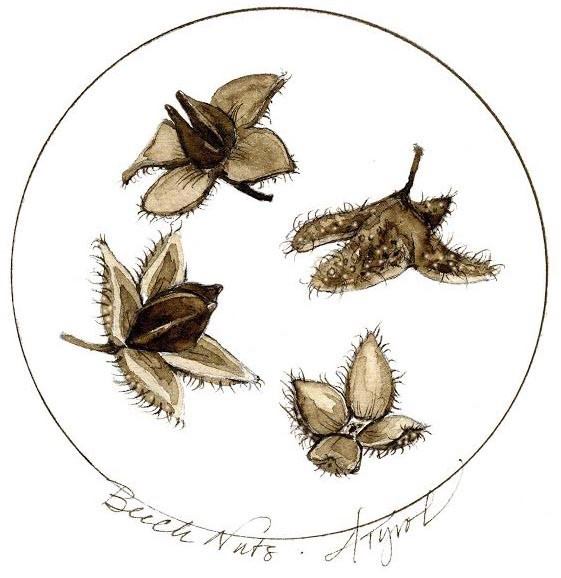
Nature writers spend a lot of time celebrating the unknowns in the natural world, those little reminders that we’re not as smart as we think we are. It’s an especially resonant message if you’re sitting at the kitchen table, surrounded by the inorganic trappings of domestic life – in other words when you need a kick in the behind – but it’s harder to appreciate when you’re afield, looking at a pile of beech nuts that look viable until you undress them and find that they have no nut meat – they’re like ghost nuts – and your three-year-old niece is saying why? why? why?, and you’re saying dun-no, dun-no, dun-no, sort of like a crow and a chickadee squawking back and forth.
Hard mast, the term used to refer to the nuts wild trees produce, is humbling this way. We know that, generally speaking, trees require a lot of energy to produce nuts, and so a tree won’t produce them every year. The books say every two or three years for beech nuts and three to seven years for oaks, but take it all with a grain of salt. We had back-to-back good acorn years around our deer camp in southern Vermont in 2010 and 2011and we haven’t had one since; our last good beech mast year was 2010.
There are advantages, from a tree’s perspective, to being unpredictable. Abundant years followed by lean years keep seed predators in check. (Biologists call this predator satiation.) In a good year, the woods are flooded with nuts – more than any squirrel or mouse can eat. The next fall, when rodent populations are high thanks to all the easy living, the trees take the year off and the surplus rodents starve.
Beech trees and rodents share the strategy of flooding an area with offspring in a way that ensures species survival, even if large numbers of individuals perish. Bears, also voracious consumers of beech nuts, have a more sophisticated reproductive strategy. In good mast years, they gorge themselves and convert the extra protein into bear cubs. In a bad year, a female bear’s body might decide in December that she’s not fat enough to give birth and will then abort the fertilized embryo she’s been carrying since June.
We know that mast production often happens on a region-wide basis: most of the beech trees in a forest will make nuts on the same year, though we don’t really know how they communicate this plan to one another. Maybe there’s some direct chemical signal – molecules that float through the air – or maybe a mycorrhizal signal gets passed underground via the fungal communities that tree roots share. Maybe the trees get cues from the environment. A warm April, say, might cause the trees to invest resources into reproduction that year, while in a cool year they will invest in growth. This phenomenon, called the Moran effect, has led some to hypothesize that as global temperatures rise, mast years will become more frequent, which could lead to an overabundance of rodents that could throw whole ecosystems out of whack.
As for the fake nuts you might find around your deer stand this year, beech expert Dave Houston confirmed for me that these were nuts that never got pollinated. Beech is wind pollinated, which leaves them susceptible to the vagaries of spring weather. A lot of rain might mean a bad pollination year. Also, the tree has relatively heavy pollen that doesn’t disperse particularly well, which might mean that dense stands of beech will have more pollinated nuts than individual beech trees growing among other hardwoods. On any mast year there will be a mix of pollinated and unpollinated nuts, though pollination rates vary widely.
Why would a tree put energy into making a fake nut? Tom Vogelmann, a plant biologist at UVM, says that the empty husks are made of carbon, which is a relatively cheap commodity to a tree. The actual nut is the expensive item, as it uses up precious nitrogen to make protein. Since it doesn’t take that much effort to make an empty nut, maybe the answer is that, like a female bear, going part way gives the tree the ability to assess its resources and make a last-minute decision about whether or not to make (a couple thousand) offspring.


Discussion *